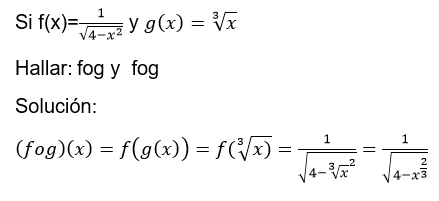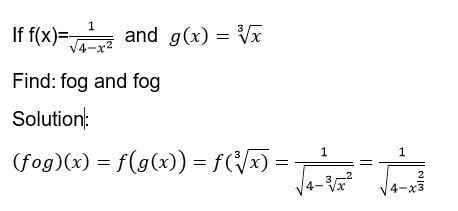
Este post lo vamos a dedicar a una operación con funciones que recibe el nombre de Función Compuesta, esta operación consiste en aplicar una función a otra función, por ejemplo, si queremos aplicar la función f(x)= x2 a la función g(x)= x +1, significa que debemos hallar esto: f(g(x).
This post is going to be dedicated to an operation with functions called Composite Function, this operation consists of applying a function to another function, for example, if we want to apply the function f(x)= x2 to the function g(x)= x +1, it means that we must find this: f(g(x).
Para hallar f(g(x) seguimos la definición de f que es la función que distinguimos como externa, y siguiendo la lógica en el razonamiento, g(x) será la función interna; de tal forma que aplicamos la función externa sobre la función interna así:
To find f(g(x) we follow the definition of f which is the function we distinguish as external, and following logic in reasoning, g(x) will be the internal function; so we apply the external function to the internal function as follows:
| f(g(x)=f(x+1)= (x +1) 2 = x2 +2x+1 |
También podemos hacer lo contrario, es decir, aplicar g sobre f, ahora, se trata de que la función externa es g y la interna es f, esto es: g(f)x)=g(x2 )= x2 +1.
We can also do the opposite, i.e. apply g on f, now it is that the external function is g and the internal function is f, that is: g(f)x)=g(x2 )= x2 +1.
Para poder identificar el orden de la composición debemos tener una notación adecuada y en tal sentido estas son las notaciones formales para la composición de funciones f y g cualesquiera:
In order to identify the order of the composition we must have an adequate notation and in this sense these are the formal notations for the composition of any f and g functions.
(fog)(x)=f(g(x)) que se lee g compuesta con f y (gof)(x)=g(f(x)) que se lee f compuesta con g.
(fog) (x)=f(g(x)) that you read g compound with f and (gof)(x)=g(f(x)) that you read f compound with g.
Es importante destacar que en la composición de g con f, g debe estar en el dominio de f, y en la composición de f con g, f deberá estar en el dominio de g.
It is important to note that in the composition of g with f, g must be in the domain of f, and in the composition of f with g, f must be in the domain of g.
Veamos un ejemplo de aplicación:
Let's look at an application example:


El lector interesado se dará cuenta que esta función resultante de la composición de g con f no está definida para x=8 y para x= -8 ya que, si la evaluamos, por ejemplo, en x=8 se nos presenta una indefinición:
The interested reader will realize that this function resulting from the composition of g with f is not defined for x=8 and for x= -8 since, if we evaluate it, for example, at x=8 we are presented with an indefiniteness:
Veamos:
Let's see:

Es claro que este resultado no existe como número real.
It is clear that this result does not exist as a real number.
Lo mismo va a ocurrir con x=-8.
The same thing is going to happen with x=-8.
Recordemos que en el post anterior obtuvimos el dominio de estas dos funciones:
Let's remember that in the previous post we got the mastery of these two functions:
Para hallar el dominio de f, resolvimos esta ecuación cuadrática

Por lo tanto: Dom(f)= (-2,2)
En el caso de g que está definida por una raíz cúbica, el Dom(g)=R.
To find the domain of f, we solved this quadratic equation

Therefore: Dom(f)= (-2,2).
In the case of g which is defined by a cube root, Dom(g)=R.
Visto esto, las condiciones que debe cumplir g para estar en el dominio de f son las siguientes:
In view of this, the conditions that g must meet in order to be in the domain of f are as follows:
Primero, debemos concentrar la idea de que g(x) debe estar en el dominio de f(x), es decir: g(x) debe pertenecer al intervalo (-2,2).
First, we must concentrate the idea that g(x) must be in the domain of f(x), i.e., g(x) must belong to the interval (-2,2).

Consecuentemente, el dominio de (fog)(x) consiste en todos los valores de x en el intervalo (-8, 8), con lo cual resolvemos el problema planteado.
Consequently, the domain of (fog)(x) consists of all the values of x in the interval (-8, 8), which solves the problem.
Se deja al lector:
a) Hallar (gof)(x)
a) Hallar el dominio de (gof)(x)
It is left to the reader:
(a) Find (gof)(x).
a) Find the domain of (gof)(x)

Créditos
El texto es original de la autora, una de las imágenes es elaborada con inteligencia artificial y la otra es de Pixabay.
Credits
The text is original from the author, one of the images is created with artificial intelligence and the other is from Pixabay.
¡Felicitaciones!
Estás participando para optar a la mención especial que se efectuará el domingo 10 de diciembre del 2023 a las 8:00 pm (hora de Venezuela), gracias a la cual el autor del artículo seleccionado recibirá la cantidad de 1 HIVE transferida a su cuenta.
¡También has recibido 1 ENTROKEN! El token del PROYECTO ENTROPÍA impulsado por la plataforma Steem-Engine.
1. Invierte en el PROYECTO ENTROPÍA y recibe ganancias semanalmente. Entra aquí para más información.
2. Contáctanos en Discord: https://discord.gg/hkCjFeb
3. Suscríbete a nuestra COMUNIDAD y apoya al trail de @Entropia y así podrás ganar recompensas de curación de forma automática. Entra aquí para más información sobre nuestro trail.
4. Visita nuestro canal de Youtube.
Atentamente
El equipo de curación del PROYECTO ENTROPÍA
Thanks for your contribution to the STEMsocial community. Feel free to join us on discord to get to know the rest of us!
Please consider delegating to the @stemsocial account (85% of the curation rewards are returned).
You may also include @stemsocial as a beneficiary of the rewards of this post to get a stronger support.